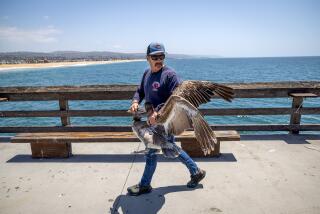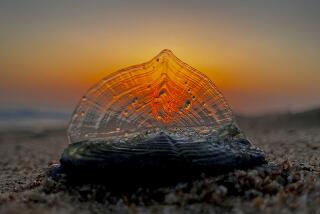Pelicans Get Lift From Friends
Like awkward teenagers, 28 brown pelicans loafed, stared at their feet and scanned the horizon.
The seabirds, just released Tuesday from a van in a wildlife refuge at Seal Beach Naval Weapons Station, needed coaxing from their human guardians before they would spread their wings and, one by one, glide to the beach on the outer rim of Anaheim Bay.
Just weeks ago, these birds would have been lucky to be able to crane their necks to groom their wings. Severely weakened by botulism, they were brought from the Salton Sea to the Pacific Wildlife Project in Irvine to be nursed back to health.
Since the mid-1990s, thousands of the endangered brown pelicans have contracted botulism after eating bacteria-laden fish at the Salton Sea. In 1996, the disease killed about 30% of the area’s pelicans, said Jihadda Govan, an official for the U.S. Fish and Wildlife Service at the Sonny Bono Salton Sea Refuge southeast of Palm Springs.
In response, the nonprofit wildlife project has become an avian M*A*S*H unit, treating as many as 600 birds at once, said Linda Evans, the center’s executive director. Ailing birds also are helped at facilities in Coachella and San Diego.
At the Irvine facility, which operates behind the city’s animal care center, about 40 volunteers try to flush toxins from the birds’ bodies, feed them a homemade formula of electrolytes and vitamins, and offer the best bedside nursing a bird can get on a fixed budget and with limited hands.
Lately, most of the arriving pelicans have been birds under age 2.
Botulism poisoning is a fact of life at many bodies of water. But the magnitude of the problem at the Salton Sea has alarmed wildlife officials.
“Botulism is a natural cause of pelican mortality in the wild,” said John Bradley, a manager at the Anaheim Bay National Wildlife Refuge. “But the number of birds we’ve had sick or dying is not natural.”
Twice as large as Lake Tahoe, the Salton Sea by its very nature is hospitable to bacteria, particularly during the summer heat of the Southern California desert. It was created in 1905 from an engineering mistake that sent a torrent of Colorado River water gushing into a salt sink. The sea has no natural drainage and is a sump for agricultural runoff.
Helping the sick birds is intensive work, filled with unpleasant sights and smells that can scare away potential volunteers, Evans said.
“You take the fact that they suffer from food poisoning with the fact pelicans don’t smell too good to begin with,” Evans said. “Add that they eat fish [and] it’s stinky work. But it’s important.”
Although the cycle of illness continues, Evans takes heart that the birds now coming to them are recovering in larger numbers.
“For a long time, about 30% to 35% of the brown pelicans that were brought to us would die,” she said. “That rate has gone down to 20%, and the number of birds dying overall has been going down. . . . But we could use more volunteers.”
More to Read
Sign up for Essential California
The most important California stories and recommendations in your inbox every morning.
You may occasionally receive promotional content from the Los Angeles Times.











